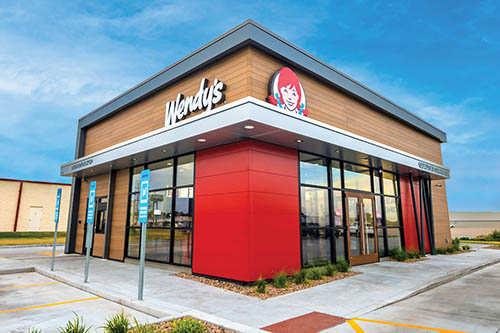— By Katie Lee —
The QSR leader never stops innovating — from the current rollout of its new Global Next Gen restaurant design to the highly anticipated launch of its future high-capacity kitchen.
It’s hard to imagine that quick-service restaurants once existed without drive-thrus, but someone had to start somewhere. In 1970, Wendy’s Founder Dave Thomas popularized the “Pick-Up Window” at a freestanding Wendy’s restaurant and that innovation became, essentially, one of the first modern drive-thrus. While the pick-up window wasn’t brand new, no one had made it work successfully before then. The slick new addition to ordering and operations was able to propel Wendy’s from a four-store hamburger chain in Columbus, Ohio, into the thriving and beloved global brand fans know today.
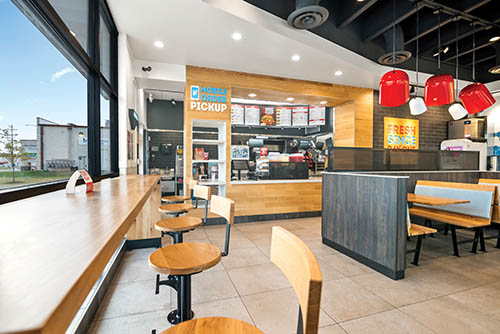
Five decades later, Wendy’s continues its legacy of innovation to accelerate growth. In 2022, the company unveiled Global Next Gen, the new global design standard for Wendy’s restaurants which leverages creative design and technology developments. Building off that design, the company is now close to launching a new high-capacity kitchen design for high-traffic locations. And so it grows.
Today, Wendy’s has more than 7,000 restaurants in over 30 markets worldwide. For the past four decades, Wendy’s has been expanding internationally and now operates approximately 1,000 restaurants outside of the United States, including its entry into the United Kingdom in 2021.

“Fast forward to 2023, and we are making strides towards our development goal of steady net restaurant growth,” says Steven Derwoed, vice president of global design and construction at The Wendy’s Company. “During the third quarter alone, we celebrated the opening of 72 global restaurants, including the first Global Next Gen restaurant.”
In August of this year, the brand celebrated the opening of the 6,000th Wendy’s restaurant in the U.S., located in West City, Illinois, featuring the new Global Next Gen design.
Global Next Gen
Harnessing the harmonies between design and technology, Wendy’s launched the Global Next Gen design last year and will soon debut a new high-capacity kitchen for its highest-demand restaurants. Much of this innovation is a direct result of customers’ changing ordering and dining habits during the COVID-19 pandemic.
“There’s no doubt the accelerated shift from dine-in to drive-thru and digital ignited by the pandemic is a trend we continue to see today,” Derwoed says. “Traditionally, most of our sales came from the drive-thru, and drive-thru remains a preferred way customers choose to interact with us. Digital sales also remain strong, with customers ordering ahead using the Wendy’s mobile app and through third-party delivery partners.”
Wendy’s developed the Global Next Gen design in partnership with key stakeholders across its global system, incorporating performance data from layout simulations and feedback from franchisees and in-house cross-functional teams — as well as an outside consultant — to ensure the design delivers an exceptional experience.
Since unveiling the Global Next Gen design, the first Wendy’s restaurants have opened in Great Bend, Kansas, and Edmond, Oklahoma, with more than 200 restaurants featuring the new design slated to open through 2024.
The new design introduced several design and technology innovations to boost operational efficiency. One of Global Next Gen’s marquee features is a dedicated walk-up window that allows delivery partners to pick up orders more quickly and efficiently. The design also features dedicated mobile order and delivery parking, and mobile order pickup shelving inside the restaurant, allowing customers to bypass in-store queues and easily grab orders at their convenience. The improved customer flow diverts traffic from the drive-thru, streamlining order pickup for the restaurant crew.
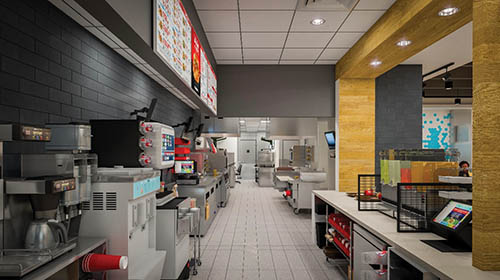
The introduction of a galley-style kitchen design is another notable feature for operations. This design optimizes the restaurant’s layout by bringing essential functions such as the point of sale (POS), coordinator station, drink station and Pick-Up Window closer to each other. This proximity enhances line-of-sight and communication among staff, leading to faster service and better coordination.
The Global Next Gen prototype is more than 10% smaller than the previous generation. “While most of the space came out of the kitchen and back of house, the crew unanimously complimented the back-of-house space, thanks to how the layout reduces steps and widens the aisle between both sides of the kitchen to give the crew more room to maneuver,” Derwoed explains.
Overall, Wendy’s new design offers improved flexibility in staffing while cutting down steps for crew members. Crew can seamlessly transition between different positions throughout the day, adapting to changing customer flow and demand. This nimble staffing approach ensures that the restaurant operates at peak efficiency, regardless of fluctuations in customer traffic.
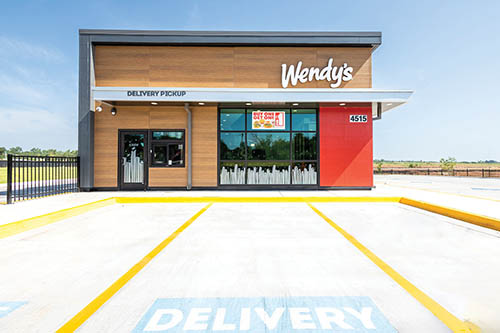
For today’s digital-first customers, the Global Next Gen design offers a new, different and more convenient guest experience. For one, it completely reimagines restaurant operations, streamlining the experience for digital and delivery customers — unlocking up to 400 times the digital capacity of previous restaurant designs. As the brand’s digital business continues to grow, Wendy’s has optimized Global Next Gen to reflect the needs of today’s digital ordering preferences.
“The focus on digital ordering has accelerated over the past few years as customers have become more comfortable with delivery, online and mobile ordering, and we expect this trend to continue,” Derwoed says. “Ultimately, customers crave speed, convenience and accuracy.”
The new design streamlines ordering via self-order kiosks, conveniently located pass-through order pickup shelving, and dedicated parking for mobile order pickup. Second, a dedicated delivery pickup window and parking spaces improve restaurant traffic flow and overall convenience for delivery partners. Third, next-generation technology enables a fast, frictionless experience for restaurant teams to handle more digital orders.
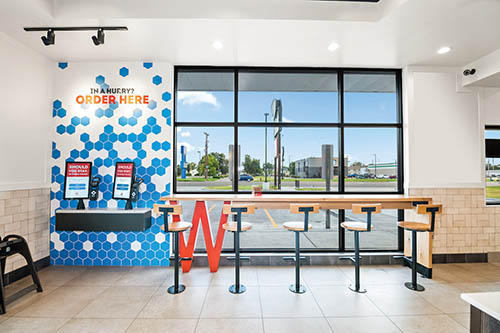
Global Next Gen also was designed to push a more modern look and feel, reflecting current tastes and cooler color palettes while celebrating Wendy’s heritage. “We used colors and materials to create an intimate environment with red accents and warm materials such as oak wood,” Derwoed says. “Wendy’s core values are reflected across the restaurant, including ‘We don’t cut corners’ featured on table corners — a nod to our signature square hamburgers. We incorporated patinated tile used as a wainscot in our distinctive ‘hamburger pattern’ and introduced an additional dark grey to the palette to create a more updated feel within the restaurant. For the exterior, we doubled down on using red, incorporating the eye-catching Wendy’s signature color into the drive-thru façade as well as the front corner of the building. This new family of designs was built to be thoughtful, simple and adaptable to serve our urban, suburban and even rural markets.”
Not only does the new design optimize costs, but Global Next Gen sets the stage for better returns for franchisees and a better experience for Wendy’s customers, delivery partners and restaurant crew. With the first Global Next Gen restaurants now open, Wendy’s is energized by the early, positive responses from customers and has seen immediate adoption from delivery drivers.
“We’re thrilled with the feedback and response from franchisees ready to grow with Wendy’s,” Derwoed says. “Global Next Gen was created with our franchisees, crew, customers and delivery drivers in mind, and it shows.”
High-Capacity Kitchen
As the company he founded continues to innovate, Dave Thomas would certainly be impressed by the new Global Next Gen High-Capacity Kitchen, which can deliver nearly a 50% increase in kitchen output capacity. The new kitchen design was built upon the foundation of the Global Next Gen restaurant design, while maximizing kitchen throughput for restaurants with the highest volume. The company is nearly ready to share technical drawings of the new kitchen design with franchisees.
“We needed a solution for restaurants with a higher order volume, which require a tailored solution for increased order throughput,” says Abigail Pringle, Wendy’s president, international, and chief development officer.
The dual-sided kitchen design features state-of-the-art equipment and layout to maximize kitchen capacity, providing crew members with the tools they need to deliver exceptional quality efficiently, including additional sandwich production areas, dedicated space for digital orders and more prep area. Reduced travel distances for crew members are the result, thanks to a strategically placed front counter, drive-thru and expanded storage capacity.
The high-capacity kitchen also features a new high-tech DSG 2.0 grill, which allows crew members to easily, quickly and consistently make to order Wendy’s hot and juicy hamburgers. The DSG 2.0 speeds cook times from 155 to 80 seconds. There’s also a USB interface that updates menus and recipes, and temperature uniformity with five independently controlled heat zones.
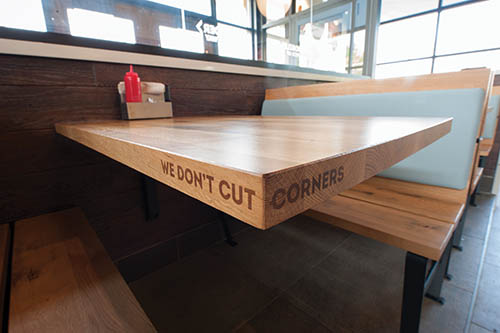
Wendy’s Global Next Gen kitchen equipment is all on wheels, making it easier to keep the kitchen clean and a great win for the crew. And because it’s off-the-shelf equipment, these pieces offer lower construction lead times and lower initial and maintenance costs.
Additionally, Wendy’s has implemented a cloud-based, digital food labeling system to enable fast and accurate printing of ingredient and shelf-life labels. The Prep Label Printer also saves time, improves accuracy and creates consistency.
Warewash machines in Wendy’s Global Next Gen kitchens automate the time-consuming task of cleaning the items used for food prep and allow crew members to focus on what they do best: serving customers.
Next up on Derwoed’s priority list is preparing to launch the technical drawings for the Global Next Gen High-Capacity Kitchen. “Aligned to our new global structure, we are making the prototype available to all countries simultaneously,” he explains. “This is only the second time in Wendy’s history we launched a design on a global scale, with the first occurring just last year, with the introduction of our new Global Next Gen restaurant design.”
With franchisees in over 30 countries, one of the challenges that Wendy’s encounters is shipping equipment all over the world. That said, the company is highly focused on in-market localization wherever possible. “It is a massive undertaking that’s shown great promise and a high degree of franchisee interest,” Derwoed says.
Pringle notes that the speed with which the Global Next Gen design plan was released to development is a testament to Wendy’s new, more nimble global structure and focus on accelerating traditional restaurant growth while increasing digital capacity.
“Looking ahead, we anticipate a net unit growth of approximately 2% in 2023,” says Pringle. “Our ambitions remain high, with projected annual net unit growth of 2-3% in 2024 and an even more ambitious target of 3-4% in 2025.”
— This article originally published as the cover story of the November 2023 issue. Email the editor, Katie Lee, at [email protected].

